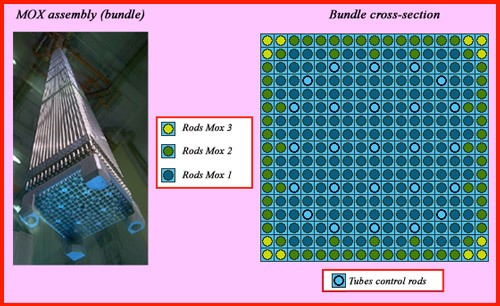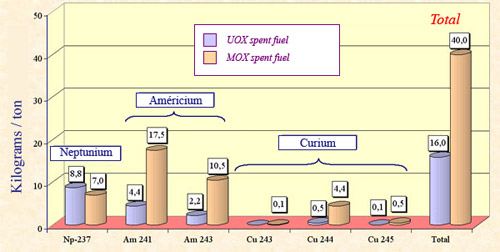Introducing plutonium in nuclear fuels
For energy production, plutonum is gold ! One gram of plutonium 239 can generate as much electricity as on ton of petrol. This fissile nucleus can therefore replace uranium 235 in nuclear reactors, enabling to economise this extremely rare and precious natural uranium isotope.

MOX fuel assembly
MOX fuel assembly in the french Melox factory at Bagnols-sur-Ceze. The plutonium fuel is far more radioactive than the uranium-based fuel. All handlings are done with robots. Their transports require special containers for radioprotection.
© PHILIPPE LESAGE /AREVA
Since 1985, some French pressurized water reactors have been adapted to burn an uranium fuel mixed with 5 to 7% plutonium. As both uranium and plutonium are present in oxidised form, the new fuel is referred to as ‘mixed oxides’ or MOX. Today, some 19 nuclear reactors in France are regularly loaded with MOX fuel.
In order not to affect the operation of Pressurised Water Reactors (which were not designed to burn plutonium), no more than 30% of MOX assemblies can be loaded alongside 70% conventional uranium fuel (UOX)) in the core of these reactors.

Composition of MOX fuel
Composition of MOX fuel for a ton of metal (uranium + plutonium). The fissile isotopes (uranium-235, Plutonium-239 and 241) represent 4.3% of the total. Uranium-235 constitutes only 0.2%, since « depleted » uranium is used in the fabrication of MOX fuels. Plutonium isotopes are much more radioactive than those of uranium. They generate a much higher radioactivity than the enriched uranium fuels (UOX).
© IN2P3
A plutonium recycling … but limited and incomplete …
MOX fuels recycle a large amount of the plutonium produced in reactors then extracted at the la Hague reprocessing plant. In order to produce a MOX assembly, it is necessary to extract plutonium from seven assemblies (or bundles) of spent UOX fuel. To use up the totality of plutonium produced today in France, 28 PWR reactors would have to be adapted to MOX fuels instead of the 20 PWR adapted today.
The burning of MOX assemblies in a reactor core generates roughly the same amount of plutonium that is destroyed. The final total amount of plutonium is reduced by only 30 %.

Distribution of fuel rods in a MOX assembly
The core of a PWR, adapted to burn plutonium, contains around 30% of MOX assemblies or bundles. One distinguishes three areas with assemblies differing by their enrichment in plutonium. The absorber rods to control the chain reaction are also shown. The distributions of the MOX assemblies in the reactor’s core are designed to not disturb the neutron flux and reactor operation.
© AREVA/CEA
Spent MOX fuels are more radioactive than their uranium counterparts and require significantly longer cooling time.
Plutonium from MOX spent fuels accumulates at a rate of 7 tons per year in France. The accumulated tonnage of MOX spent fuels to be stored in intermediate storage pools is foreseen to reach 4000 tons in 2035. When the time would come, wisdom would require that this plutonium would be used to feed fast neutron breeder reactors able to burn it. The opponents to nuclear power who call for its full shutdown should realize that without the construction of burners reactors, the burden of this accumulated plutoniun would fall on the shoulders of future generations !
Around 30% of the plutonium isotopes in MOX fuels are not fissile with slow neutrons and can not be burned in conventional reactors of the PWR type. To burn the plutonium, the use of MOX with these reactors is inefficient compared to the performance of fast reactors.
The multiple recycling of spent MOX fuels has been proven feasible technically, but is too expensive to be considered. While today reactors are unfit to use multiple recycled plutonium, this plutonium would be an excellent fuel for fast neutron reactors !

Increase of minor actinides in spent MOX fuels
This diagram compares the production of minor actinides in PWR reactors using standard uranium fuel (UOX) or in fuel containing 30% MOX and therefore plutonium. The numbers correspond to an annual load of 20 tons of heavy metal (uranium and plutonium). More minor actinides are produced in the MOX fuel, formed more easily from plutonium nuclei. Minor actinides increase the long-term radiotoxicity of radioactive waste : a disadvantage of MOX fuels.
© IN2P3
Application to the destruction of weapon-grade plutonium
It is also possible to produce MOX fuel by incorporating highly-enriched weapon-grade plutonium. Once burned in a reactor, the plutonium become unfit for a weapon. The Russians and the Americans have both expressed an interest in using such techniques to destroy the plutonium surplus of their nuclear arsenals. On the 23rd of January 2002, the Bush administration announced that it would be using MOX fuel as a way of getting rid of its excess military plutonium.
Other articles on the subject « Nuclear Fuel »
Nuclear Fuel Cycle
The front-end and the back-end of the cycle… The nuclear fuel cycle includes all nuclear op[...]
Cycle Front End
From the extraction of uranium to the fuel fabrication The front-end of the nuclear cycle is the [...]
Isotopic Separation
The access key to the fuel of modern nuclear power plants … and to atomic weapons The uranium fue[...]
Ultracentrifugation
A separation process economical in energy, but proliferating The principle of centrifuges has lon[...]
Gaseous Diffusion
The first enrichment process, a large consumer of electricity The gaseous diffusion process was t[...]
PWR fuel assemblies
Fuel assemblies in the core of PWR Reactors The core of a pressurized water reactor (PWR) is cont[...]
Reactor fuel layout
Fuel assemblies in the core of nuclear reactors The nuclear fuel assemblies, that vary from one r[...]
Plutonium Use
A fissile element produced in nuclear reactors In February 1941 the American physicist Glenn Seab[...]
Pu : Fuel, bomb or Waste ?
Plutonium dark and bright sides … Sensitive material, like the roman god Janus, plutonium h[...]
Thorium Fuels
Uranium 233: a fissile nucleus made from thorium Thorium is more abundant than uranium in the Ear[...]